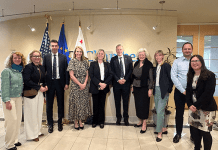 The $5.2 billion Panama Canal Expansion has opened to transit and will double the waterway’s cargo capacity, enhancing the canal’s efficiency, reliability and customer service.
The $5.2 billion Panama Canal Expansion has opened to transit and will double the waterway’s cargo capacity, enhancing the canal’s efficiency, reliability and customer service.
The new waterway will provide greater economies of scale to global commerce. The expanded Panama Canal will now allow for Neopanamax ships, vessels holding 5,000 to 14,000 containers, to pass through its channel. Previously, only smaller cargo ships could squeeze through the narrow passage, making high-volume Asian shipments to the East Coast difficult.
A California legislative delegation was in attendance at the canal opening and included Assembly Speaker Anthony Rendon, (D-Paramount), Assembly Speaker Emeritus Toni Atkins ( D-San Diego), and Assemblymen Tony Thurmond (D-Richmond) and Jose Medina (D-Riverside).
Early on June 26, the inaugural transit of the Panama Canal Expansion began with the transit of Neopanamax vessel COSCO Shipping Panama through the new Atlantic-facing Agua Clara Locks. Originally named Andronikos, the vessel was renamed to honor and pay respect to the country of Panama and the canal. Panamanian President Juan Carlos Varela and Panama Canal Administrator and CEO Jorge L. Quijano honored the almost 40,000 workers—who made the expansion a reality—with a message of pride, accomplishment, hope and opportunity. COSCO Shipping Panama set sail June 11 from the Greek Port of Piraeus carrying 9,472 twenty-foot equivalent units (TEUs) and measuring 299.98 meters in length and 48.25 meters in beam.
The expansion is the largest project at the canal since its original construction. The project created a new lane of traffic along the Panama Canal through the construction of a new set of locks, doubling the waterway’s capacity, having a direct impact on economies of scale and international maritime trade.
The canal was under U.S. control until a 1977 agreement between U.S. President Jimmy Carter and Panamanian Commander Omar Torrijos paved the way for its transfer to Panama on December 31, 1999. Canal authorities say it generated $10 billion in direct income for the Panamanian state through 2015. With related economic activity, the canal is responsible for about 40% of Panama’s gross domestic product (GDP). On average, 35 to 40 ships transit the waterway each day, and the canal is estimated to handle 6% of world maritime commerce.
Work to expand the Panama Canal officially began in September 2007. The program consists of several components:
- New Locks (Third Set of Locks);
- Pacific Access Channel;
- Improvement of Navigational Channels (Dredging);
- Improvements to Water Supply.
The Panama Canal expansion is based on six years of research, which included more than 100 studies on the economic feasibility, market demand, environmental impact and other technical engineering aspects.
The expansion program is the canal’s largest enhancement project. In 2006, more than 75% of Panamanians approved the project in a nationwide referendum. Construction of the $5.25 billion project began in 2007. It included the construction of a new set of locks on the Atlantic and Pacific sides of the waterway and the excavation of more than 150 million cubic meters of material, creating a second lane of traffic and doubling the cargo capacity of the waterway.
In 2015, the original canal set a tonnage record, transiting 340.8 million PC/UMS (Panama Canal/Universal Measurement System; 1 PC/UMS net ton equals 100 cubic feet of capacity).
The original canal will continue to operate, transiting Panamax-sized vessels, which can hold up to 5,000 containers of products or smaller. Although the expansion’s locks are 70 feet wider and 18 feet deeper than those in the original canal, they use less water due to water-savings basins that recycle 60% of the water used per transit.
Completion of the expansion is expected to lead to the introduction of new routes, liner services, and segments (such as liquefied natural gas).


